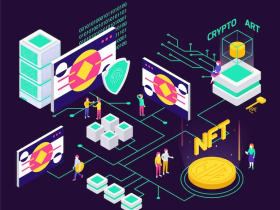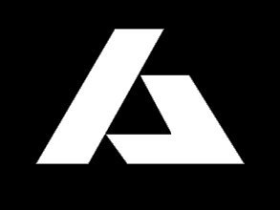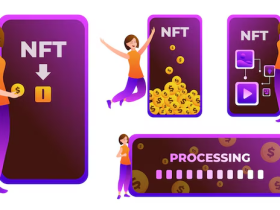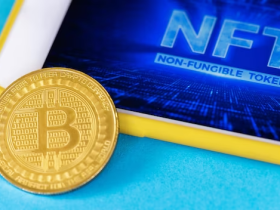The unique digital assets known as nonfungible tokens (NFTs) are kept on a blockchain and are used to verify the legitimacy or ownership of specific items, most commonly works of art, collectibles, or virtual real estate. Developing the digital product in question, including any underlying programming, design, or creative elements, is the process of making an NFT. On the other hand, NFT minting comprises the cryptographic procedure of generating a distinct token linked to the digital item and securely integrating it into the blockchain record.
Despite their frequent overlap, these phrases refer to different stages in the process of creating a unique digital asset on a blockchain. In this post, we’ll examine the distinctions between NFT minting and NFT creation.
NFT Production: The Creative Method
As previously said, the process of creating NFTs is essentially artistic and entails the ideation, design, and construction of unique digital assets. The distinctive visual, audio, or interactive elements that developers, producers, and artists contribute to NFTs make them fascinating and one-of-a-kind.
Through virtual experiences, collectibles, or digital art, the process demands expression, creativity, and innovation. The artistic element is vital to the production of every NFT since it is a reflection of the artist’s skill and creative vision.
The Idea
The genesis of the concept, which can come from a variety of sources like music, art, collectibles, or in-game items, is the first stage in making an NFT. During this stage, which stands for the idea’s conception, artists envision and plan the unique digital asset they want to realize. While musicians write melodies and artists sketch designs, developers plan out the details of virtual objects. At this fundamental step, the creative spark ignites and also sets the course for the subsequent stages of NFT production.
Production of Digital Files
Using a range of software tools designed for the particular medium, the digital file is really developed at the second stage. Visual artists often utilize programs like Photoshop or Blender to create intricate patterns or three-dimensional objects.
Musicians utilize programs like FL Studio or Ableton Live for music production in order to write and compose songs. These software packages handle a wide range of file formats, including JPEG and PNG for images, MP3 and WAV for audio, and MP4 for videos. In this stage, artists refine their creations to make sure they fulfill the technical specifications required to be certified as NFTs. To draw in collectors or possible customers, they also enhance its aesthetic or acoustic appeal.
NFT minting: The application of blockchain
The stages involved in minting NFTs are:
Selecting a blockchain
Developers should take into account a blockchain’s functionality, price, and community support before deciding which one to use for NFT minting. Ethereum, the first blockchain for NFTs, is extensively used and works with well-known NFT marketplaces.
But due to its costly gas costs and clogged network, artists search for substitutes like Solana, which is a popular choice for minting NFTs due to its lower fees and faster transaction times, particularly in light of Ethereum’s scalability issues.
Additionally, new blockchains like Flow from Dapper Labs provide special capabilities for NFTs like native support and smart contracts made to manage digital collectibles on a big scale. In the end, developers must weigh the trade-offs between cost, functionality, and ecosystem support, taking into consideration factors like transaction speed, security, and long-term sustainability. This will help them determine which blockchain is most suited for minting their NFTs.
NFT markets
Artists can mint their digital assets as NFTs on NFT markets like as OpenSea and Rarible, where buyers can buy, sell, and trade them. These platforms offer easily accessible and user-friendly interfaces for minting NFTs, as well as the ability for authors to establish ownership rights, calculate royalties, and upload digital files. A variety of NFT collections may be browsed, new artists can be discovered, and users can take part in auctions and direct transactions.
While OpenSea, one of the largest NFT marketplaces, offers a wide range of digital assets, Rarible distinguishes out for adopting a decentralized strategy, giving creators governance rights, and promoting a community-driven economy. These platforms facilitate the lively interchange of digital assets and the democratization of digital ownership within the growing NFT ecosystem.
NFT Minting Procedure
Uploading the digital file to the chosen blockchain platform is a vital initial step in the NFT minting process. Next, makers typically select an NFT marketplace that works with them, such Rarible or OpenSea. Critical metadata, including a title, description, and attributes, are added by the creators once the file is posted. These details provide collectors and potential buyers with background knowledge about the NFT.
Once the metadata is provided, a smart contract that governs ownership rights and the transactional elements of the NFT is constructed. This contract consists of a set of instructions for blockchain code that define things like royalties, resale rights, and provenance monitoring.
It’s important to remember that every transaction has “gas fees,” which cover the computational costs related to managing and confirming transactions on the blockchain. These fees are influenced by both network congestion and transaction complexity. When minting their NFTs, designers need to consider these fees because they might have a big effect on the overall cost of launching the product.
Important Distinctions Between Minting and Nft Creation
While NFT minting focuses on making the NFTs blockchain verifiable, NFT creation involves creating the innovative idea. Pre-minting ownership is retained by the creator, whose work comes before minting. However, minting establishes public, verifiable ownership on the blockchain, ensuring the legitimacy and traceability of the digital asset.
Why is It Important to Distinguish Between Minting and Creating Nfts?
Knowing the difference between NFT creation and minting is necessary to comprehend the full life of NFTs. While creation signifies the inception and development of the digital asset, minting establishes its ownership and immutability by placing it on the blockchain. This distinction is crucial since it aids in the authors’ thorough navigation of the NFT ecosystem’s intricacies.
Apart from bestowing upon the public ownership, minting enables writers to set up royalties for subsequent sales, guaranteeing ongoing compensation for their efforts. By knowing this distinction, creators may plan their approach to NFTs by considering factors like platform fees, resale royalties, and long-term profitability.
Nfts and Concerns About Intellectual Property (IP) Rights
There are a ton of possible intellectual property (IP) problems when creating and minting NFTs. It’s important to realize that ownership of the underlying work is not instantly transferred upon creation of an NFT. If the author of an NFT uses someone else’s copyrighted picture, song, or brand, they could face legal action for infringement. Minting the NFT can lead to buyers thinking they have acquired complete ownership rights and introduces even more complication to the situation.
Creators must use their original work or secure the required licenses prior to minting. Buyers need to do due diligence, which includes studying the terms of the smart contract and the NFT’s history, in order to fully understand the rights they are purchasing. The legal environment surrounding NFTs and intellectual property is always changing, so it is crucial to get qualified legal advice when managing a potentially sensitive IP in NFT ventures.










Leave a Reply